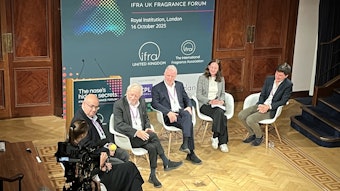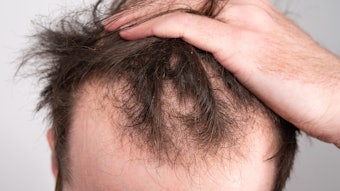Extracts from herbal materials are inherently complex, and Chinese licorice is no exception. To date, close to 40 different compounds have been characterized in this extract, most of which have a rather unusual structure (see Figure 1). The main components are isoflavonoids; the isoflavans licoricidin and licorisoflavan A account for more than 15% of the extract. A number of other isoflavans, isoflavanones and isoflavones; licoricone and licoisoflavone B; pterocarpans; flavones such as liquiritigenin; and 2-arylbenzofurans have also been described (see Chinese Licorice Compounds).1 In addition, the extract contains coumarins, coumestans, fatty acids, glycosides of liquiritigenin and isoliquiritigenin, and triterpene glycosides, i.e., saponins which give licorice roots its typical sweet taste.
One characteristic of most of these flavonoids is the addition of one or two isoprene units to the base structure. Isoflavanoids are rather rare in nature, and some of the subgroups, e.g., the coumestans and 2-arylbenzofurans, have less than 100 structures reported to date—compared with more than 1,000 known flavones and more than 1,500 flavonols. The addition of one or two isoprene units makes for an even more unusual chemical structure. The isoprene moiety can be open, as with licoricidin, or form a pyran-ring, e.g., licoisoflavone B. Publications on the relationship between the chemical structure and antibacterial activity of isoflavonoids have shown that isoprene substituents are important for such activity.1, 2 Molecules with two isoprene substituents have better activity than those with only one, which in turn have better activity than isoflavonoids without a prenyl moiety. An isoprene unit in position C-6 seems to be particularly important, as is a hydroxyl substituent in position C-7. In cases where the isoprene unit is fused to form a pyran ring, the activity noticeably decreases.2 The antimicrobial effect of isoflavones has been attributed to their phenolic hydroxyl groups, which allow the molecules to act as inhibitors of microbial enzymes. The presence of isoprene groups increases the lipophilicity of the isoflavonoid, which seems to be a requirement to disrupt the function of the protoplasmic cell membrane of Gram-positive bacteria and thus interfere with the transport of nutrients into the cell.3
Glycyrrhiza uralensis (Chinese Licorice) Sources
As a background, Glycyrrhiza uralensis is found in dry, grassy plains and on sunny mountainsides in northeastern and northwestern China, as well as in Siberia and Mongolia. Most of the current supply comes from northwest China. The annual production of herbal material from this plant is more than 60,000 tons and since its natural habitats are severely disturbed due to overharvesting, the plant is now under protection in China. Thus, this market supply comes from extensive cultivation.4 The aerial parts are usually cut in autumn and the roots are dug up, cleaned and dried using heat exchangers or left at ambient temperature; the optimum drying temperature is 35–40°C.5 Much of the material is sold to Japan as peeled root for infusions.
Anti-aging and Anti-inflammation Effects
Chinese licorice roots are among the most widely used herbs in traditional Chinese medicine (TCM), often in combination with other TCM ingredients. The Chinese call licorice gan-cao, which means “sweet herb.” The roots are traditionally used to strengthen the spleen and augment one’s energy or qi. Further, they are indicated to moisten the lungs and stop coughing, relieve pain, eliminate toxins and harmonize other herbs.6
It is important to note there is no evidence of the licorice extract from this root as having any of the benefits described by TCM. However, available in vitro data shows it does significantly decrease the production of anti- inflammatory cytokines (TNF-α, IL-1β, IL-6 and IL-8) in macrophages and whole blood at levels of 5–10 μg/mL. This was reportedly due in part to a reduction in the activities of transcription factors AP-1 and NF-κB.7
The extract and its two major components of licoricidin and licorisoflavan A were also able to reduce the production of matrix metalloproteinases (MMPs), in particular MMPs 7, 8 and 9. MMPs are a family of enzymes capable of breaking down extracellular material during physiological and pathological processes. They are involved in tissue repair as well as the inflammation and invasion of cancer cells. In the oral cavity, the continuous release of MMPs has even been proposed as a key step in the progression of periodontitis.8, 9
Licoricidin significantly reduces the secretion of MMPs 7 and 8 at 100 ng/mL and MMP-9 at 500 ng/mL. Both licoricidin and licorisoflavan A have also been shown to reduce the activity of the NF-κB but not to influence AP-1.10 Consistent with these findings is a study on a hexane-ethanol extract of Chinese licorice, which showed a decrease in secretion of MMPs 2 and 9 in DU145 prostate cancer cells. In this case, bioactivity-guided fractionation using the inhibition of EGF-induced cell migration as the measure for bioactivity led to the identification of licoricidin as the active component in the extract.11
A hexane/ethanol extract of Glycyrrhiza uralensis, containing no detectable amounts of glycyrrhizin, was proven to exert potent anti-inflammatory effects in macrophages and in mouse skin. Treatment of the macrophages with this extract led to a decrease of mRNA levels of NF-kB, which would explain the reduced levels of NO and prostaglandin E2 production in the licorice-treated macrophages. In the mouse model, the extract suppressed skin swelling and cyclooxygenase-2 expression.12 Finally, among numerous skin-lightening and -whitening patents, one 0.05–0.2% extract was proven beneficial as a skin-whitening agent.13
Antibacterial Effects
A number of isolates present in the extract have shown in vitro antibacterial effects. Hatano and co-workers tested licoricidin, glyasperin C, glyasperin D, 6,8-diprenylgenistein [8-(γ, γ -dimethylallyl)-wighteone], licocoumarone and glycycoumarin against methicillin-resistant Staphylococcus aureus (MRSA). The isoflavone 6,8-diprenylgenistein [8-(γ, γ-dimethylallyl)-wighteone] was the most potent inhibitor of MRSA with an MIC value of 8 μg/mL, while the other five compounds had MICs of 16 μg/mL. Interestingly, licoricidin was able to reduce the MIC value of oxacillin: the addition of 4 μg/mL of the compound lowered the MIC of oxacillin from 128–256 μg/mL to 8–16 μg/mL, and 8 μ/mL reduced it to less than 500 ng/mL.14
In a similar experiment, licoricidin, glyasperin D, vestitol, licoricone, gancaonin and glycyrin were evaluated for antibacterial activities against Gram-positive bacteria: two methicillin-sensitive Staphylococcus aureus (MSSA) strains, two MRSA strains, Micrococcus luteus and Bacillus subtilis; and the three Gram-negative bacteria: Escherichia coli, Klebsiella pneumonia and Pseudomonas aeruginosa. The most potent inhibitor of the Gram-positive bacteria was gancaonin, with MIC values between 1.56 and 3.13 μg/mL depending on the test bacteria, followed by licoricidin with MIC values between 3.13 and 6.25 μg/mL, and glyasperin D with MIC between 6.25 and 12.5 μg/mL. The other compounds were considerably less active, and none of the Gram-negative bacteria showed any sensitivity to the licorice isolates.15
The same research group also investigated isolates from G. uralensis against four strains of Helicobacter pylori, a bacteria known to be involved in the development of gastric ulcers. Licoisoflavone B was the most potent inhibitor of H. pylori growth, with MIC values of 6.25 μg/mL. Good inhibitions were seen with licoricidin, having MIC between 6.25 and 12.5 μg/mL; glyasperin D, with MIC between 6.25 and 12.5 μg/mL; and gancaonin, with MIC between 12.5 and 25 μg/mL.16
The benefits of oil-soluble licorice extracts for the treatment of acne were described in a Japanese patent by Sugimoto et al.17 The composition contained 0.005–10.0% w/w, preferably 0.05–1.0%, of an oil-soluble extract derived from licorice. Also included in the tested formula were 0.01–5.0% w/w, preferably 0.1–2.0%, of a corneal exfoliative agent, e.g., glycolic acid, salicylic acid and resorcinol; and/or 0.01–5.0% w/w, preferably 0.1–1.0%, of at least one anti-inflammatory agent, e.g., glycyrrhizic acid, glycyrrhetic acid or methyl salicylate. The success of this acne treatment with oil-soluble licorice extracts may have been due to the remarkable antibacterial activity of the extract against Propionibacterium acnes, with the benefit of inducing negligible resistance, in comparison with erythromycin.18
Antiviral Effects
A research group in Korea also looked at the antiviral properties of lipophilic isolates from Chinese licorice. The compounds were tested in vitro for the inhibition of both group A rotaviruses and neuramidase, a surface protein of the influenza virus.19, 20 The researchers proposed that glyasperin C, glyasperin D and glycyrin may interfere with an early stage of viral infection, and that glycyrin was also able to block virus replication with an EC50 of 12.1 μM.
Breath-freshening Effects
The author’s work, described here in brief for proprietary reasons, aimed to demonstrate the beneficial properties of licorice for oral health by examining the effects of licoricidin, licorisoflavan A, glyasperin D, allolicoisoflavone A, glycyrin and glycycoumarin on the growth of the oral pathogens Streptococcus mutans, S. sobrinus, Porphyromonas gingivalis, Prevotella intermedia, and Fusobacterium nucleatum. A supercritical CO2 extract from Chinese licorice was prepared and its effects were tested in vitro (data not shown). The extract was then clinically tested by dissolving it into a vehicle and incorporating it into a toothpaste formulation.
Effects on microorganisms: Growth inhibition of F. nucleatum was observed only with licoricidin. On the other hand, the growth of P. intermedia was inhibited by licoricidin, licorisoflavan A, glyasperin D, allolicoisoflavone A, glycyrin and glycycoumarin, although allolicoisoflavone A was the least active. Complete growth inhibition of P. gingivalis was obtained with licoricidin and licorisoflavan A.1 Interestingly, licocoumarone was found to inhibit the influenza virus neuramidase with an IC50 of 27.8 μM while other isolates, i.e., licorisoflavan A, glyasperin C, glyasperin D, liquiritigenin, glycyrin and isoglycyrol, were considerably less active.
Clinical study: A monadic clinical study was designed including 22 subjects. After a one-week pre-treatment phase in which subjects brushed their teeth twice daily with a fluoride-containing toothpaste and soft-bristled toothbrush, subjects refrained for 24 hr from eating odor-causing foods or drinks, e.g., garlic, onions or alcohol. Oral malodor was assessed using a portable gas chromatograph to determine a volatile sulfur compound (VSC) score, and by three trained odor judges on a nine-point scale. Only subjects with an odor score ≥ 150 ppb were included in the study. After an initial evaluation 12 hr after cleaning, the subjects brushed their teeth with the licorice extract-containing toothpaste. Three hours later, the subjects were re-evaluated using the same methodology as indicated. The mean organoleptic ratings by the odor judges (see Table 1) showed a 31.7% reduction in oral malodor, while the results with the VSC score (see Table 2) were reduced by 48.4%, compared with the baseline.
Important to note is the fact that due to the absence of a placebo control in this study, the breath-freshening activity could not be attributed to the licorice alone. However, a human saliva model and in vitro and ex vivo data showed that the licorice extract and two isolates licoricidin and licorisoflavan A were able to reduce the production of VSC by P. gingivalis, P. intermedia and S. moorei, with MICs between 2–8 μg/mL for licoricidin and licorisoflavan A, and 20–80 µg/mL for the extract. The extract and isolates did not inhibit the proteolytic activity of bacteria, but instead blocked the conversion of cysteine into VSCs by P. intermedia (data not shown).21
Applications
Supercritical extracts of herbal materials are generally very lipophilic and due to this characteristic, the described extract is insoluble in water or other polar organic solvents. The material is highly viscous and sticky. However, it is relatively easily incorporated into the oil phase of emulsions and generally works well in creams and pastes. The material is also pH-sensitive, so ideally, it should be used in a system with an acidic to neutral pH (pH 4–8); some isoflavans, e.g., licoricidin and licorisoflavan A, are not stable in a highly alkaline pH environment.1
Conclusions
Few plants have been used for so long and studied so extensively as licorice. While the majority of published research is on the saponins or the flavonoid-glycosides, this work has focused on the lipophilic components of Chinese licorice roots. The lipophilic phytochemicals are particularly well-extracted using supercritical CO2, and many of the compounds found in this extract have unusual structural features, which show exceptionally good anti-inflammatory and antibacterial properties in vitro. This material thus has potential implications for cosmetic and personal care if formulated in the proper vehicle and at the right level.
References
1. S Gafner et al, Isoflavonoids and coumarins from Glycyrrhiza uralensis: Antibacterial activity against oral pathogens, and conversion of isoflavans into isoflavan-quinones during purification, J Natural Products 74(12) 2514–2519 (2011)
2. AP Mukne, V Viswanathan and AG Phadatare, Structure pre-requisites for isoflavones as effective antibacterial agents, Pharmacogn Rev 5(9) 13–18 (2011)
3. M Murphy Cowan, Plant products as antimicrobial agents, Clin Microbiol Rev 12(4) 564–582 (1999)
4. JT Zhang, B Xu and M Li, Diversity of communities dominated by Glycyrrhiza uralensis, an endangered medicinal plant species, along a precipitation gradient in China, Bot Studies 52 493–501 (2011)
5. R Zimmermann and A Dorjgotov, Guidelines for medicinal and aromatic plants—A report on behalf of the German Agency for Technical Coorporation, Regional Economic Development Programme Mongolia (2008)
6. J Chen and T Chen, Gan Cao (Radix Glycyrrhizae), ch 17 in Chinese Medicinal Herbology and Pharmacology, Art of Medicine Press, City of Industry, CA (2004) pp 866–871
7. C Bodet et al, A licorice extract reduces lipopolysaccharide-induced pro-inflammatory cytokine secretion by macrophages and whole blood, J Periodontol 79 (9) 1752–1761 (2008)
8. T Sorsa et al, Matrix metalloproteinases: Contribution to pathogenesis, diagnosis and treatment of periodontal inflammation, Ann Med 38(5) 306–321 (2006)
9. T Sorsa et al, Matrix metalloproteinases (MMPs) in oral diseases, Oral Dis 10(6) 311–318 (2004)
10. VD La et al, Modulation of matrix metalloproteinase and cytokine production by licoricidin and licorisoflavan A: Potential therapeutic approach for periodontitis, J Periodontol 82(1) 122–128 (2011)
11. SY Park et al., Hexane-ethanol extract of Glycyrrhiza uralensis containing licoricidin inhibits the metastatic capacity of DU145 human prostate cancer cells, Br J Nutr 104(9) 1272–1282 (2010)
12. HJ Cho et al, Hexane/ethanol extract of Glycyrrhiza uralensis licorice exerts potent anti-inflammatory effects in murine macrophages and in mouse skin, Food Chem 121 959–966 (2010)
13. US Pat 5,609,875, Skin whitening composition, Fischer Pharmaceuticals (Mar 1997)
14. T Hatano et al., Phenolic constituents of licorice. VIII. Structures of glicophenone and glicoisoflavanone and effects of licorice phenolics on methicillin-resistant Staphylococcus aureus, Chem Pharm Bull 48(9) 1286–1292 (2000)
15. T Fukai et al, Antimicrobial activity of licorice flavonoids against methicillin-resistant Staphylococcus aureus, Fitoterapia 73(6) 536–539 (2002)
16. T Fukai et al, Anti-Helicobacter pylori flavonoids from licorice extract, Life Sci 71(12) 1449–1463 (2002)
17. Japanese Patent JP-11-100324, Composition for treating pimple, M Sugimoto et al, (1999)
18. C Nam et al, Anti-Acne effects of oriental herb extracts: A novel screening method to select anti-acne agents, Skin Pharmacol Appl Skin Physiol 16(2) 84–90 (2003)
19. HJ Kwon et al, In vitro anti-rotavirus activity of polyphenol compounds isolated from the roots of Glycyrrhiza uralensis, Bioorg Med Chem 18(21) 7668–7674 (2010)
20. YB Ryu et al, Inhibition of neuramidase activity by polyphenol compounds isolated from the roots of Glycyrrhiza uralensis, Bioorg Med Chem Lett 20(3) 971–974 (2010)
21. SI Tanabe et al, Reduction of bacterial volatile sulfur compound production by licoricidin and licorisoflavan A from licorice, J Breath Res 6(1) 016006 (2012)












